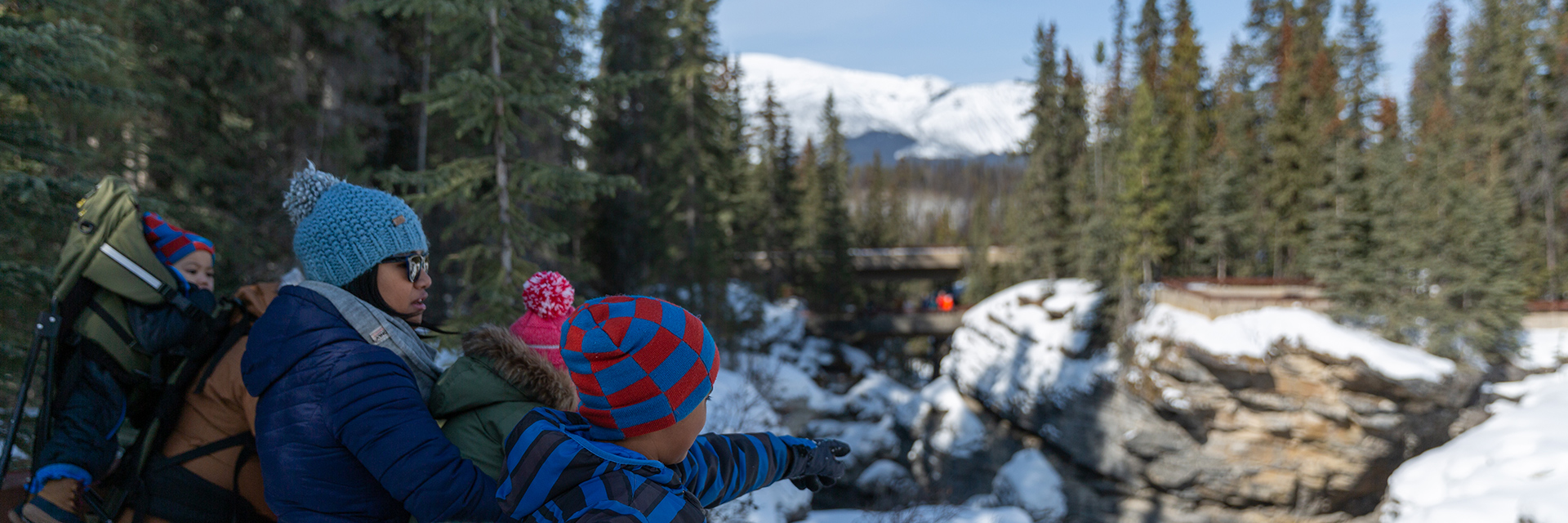
2023 Annual Report
Jasper National Park
Download the 2023 Annual Report (PDF, 2 MB)
Jasper National Park stats 2023
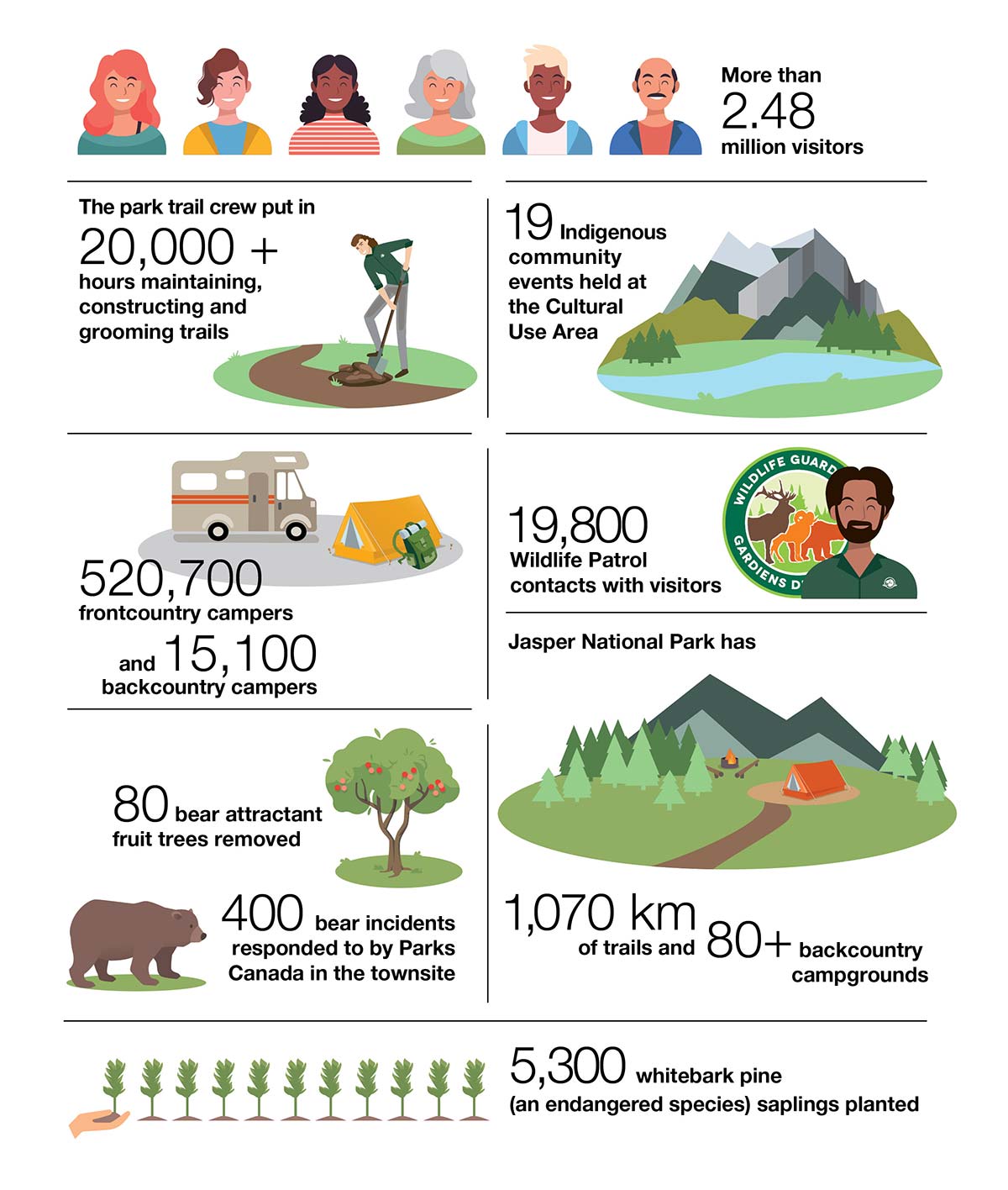
Text version
Jasper National Park stats 2023
- More than 2.48 million visitors
- The park trail crew put in 20,000+ hours maintaining, constructing and grooming trails
- 520,700 frontcountry campers and 15,100 backcountry campers
- 80 bear attractant fruit trees removed
- 400 bear incidents responded to by Parks Canada in the townsite
- 19 Indigenous community events held at the Cultural Use Area
- 19,800 Wildlife Guardian contacts with visitors
- Jasper National Park has 1,070 km of trails and 80+ backcountry campgrounds
- 5,300 whitebark pine (and endangered species) saplings planted
Introduction
Parks Canada is pleased to present highlights of our work in Jasper National Park in 2023. Thank you to Indigenous partners, stakeholders, visitors, community residents and local businesses who all play an important role in protecting Jasper National Park and fostering public understanding, appreciation and enjoyment of this special place.
This report follows the same structure as the Jasper National Park Management Plan (2022) and reports on progress in six strategy and two management areas:
- Conserving Natural and Cultural Heritage for Future Generations
- True-to-Place Experiences
- Strengthening Indigenous Relations
- Connect, Collaborate and Learn Together
- Managing Development
- Climate Change and Adaptation
- Management Area: Community of Jasper
- Management Area: Tonquin Valley
Strategy 1: Conserving Natural and Cultural Heritage for Future Generations
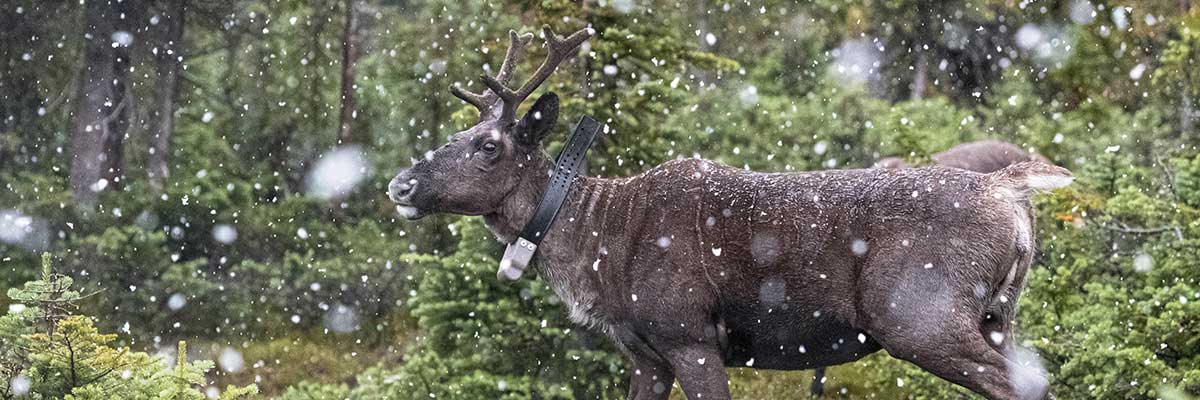
Photo :Photo: Parks Canada / Lalenia Neufeld
Southern mountain caribou recovery
Parks Canada is advancing work to recover caribou, a threatened species in Jasper National Park. Construction of the caribou conservation breeding centre began in March 2023 and is 40% complete. The main structures for three buildings are in place and vegetation clearing, to protect caribou from injury in the pens and from the risk of wildfire, is also complete.
Indigenous Partnerships
Parks Canada is building strong and mutually beneficial working relationships with Indigenous partners through the caribou recovery project. Throughout 2023, Indigenous partners were hired as subcontractors for some of the construction work on the breeding centre, harvested culturally important plants before they were disturbed at the construction site, joined Parks Canada staff in caribou monitoring fieldwork, and collaborated with Parks Canada in planning a lichen collection program in their communities.
Monitoring
Jasper National Park’s monitoring program uses annual surveys, GPS collars, remote cameras, scat DNA analysis and modelling techniques to estimate caribou populations. Using all available data to estimate the Tonquin caribou population’s size, Parks Canada estimates there are about 50 Tonquin caribou, including 8 - 13 reproductive females. Only one male and one female were observed in the Brazeau caribou range; remote cameras indicate that at least three or four of the animals remain.
Species at risk
Parks Canada is responsible for the protection and recovery of species listed under the Species at Risk Act in national parks. Part of that work includes travelling for weeks by horseback to collect data at various remote sites.
Bats - Endangered
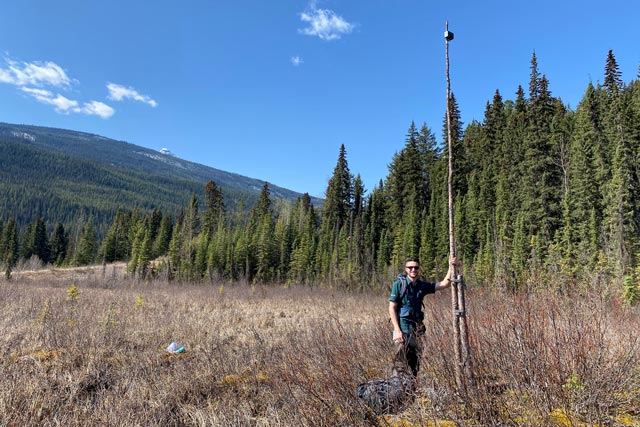
Photo :Photo: Parks Canada / Nina Veselka Parks Canada / Nina Veselka
Three migratory bat species that spend their summers in Jasper National Park were added to the Species at Risk Act in 2023: the hoary bat, eastern red bat, and silver-haired bat. They, like the little brown bat and northern myotis that winter in Jasper National Park, are all listed as endangered. Acoustic monitoring, as part of the North American Bat Monitoring Program, continues at six sites in the park to detect changes in populations and activity. This monitoring helps Parks Canada staff develop a better understanding of the bats and will aid in early detection of the fungus which causes white-nose syndrome.
Black swift – Endangered
There is little information about black swifts’ preferred microclimate for nesting sites in Canada. To help fill this gap in our knowledge, Parks Canada has collected data on temperature and humidity at the nesting sites of these small birds at Athabasca Falls and Maligne Canyon. This data will help identify the habitat needs of black swifts, which will inform management decisions to protect this species at risk.
Wolverine - Special Concern
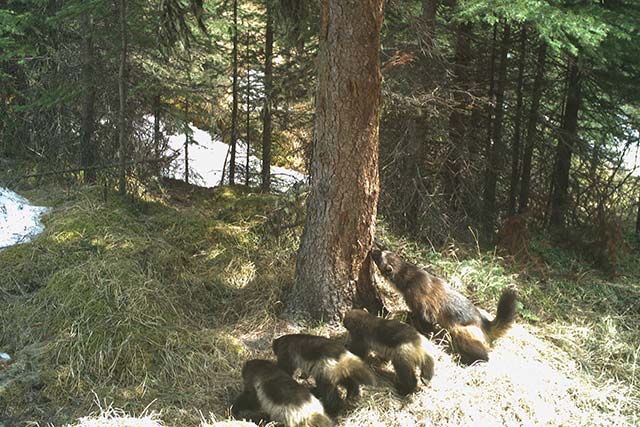
Photo :Photo: Parks Canada remote camera Parks Canada remote camera
A study conducted in Alberta and British Columbia, including Banff, Yoho and Kootenay national parks, found that wolverine populations declined by 39% from 2011 to 2020. Notably, wolverine populations are three times higher inside protected areas than outside. Parks Canada has been monitoring wolverines in Jasper National Park using remote wildlife cameras since 2012, aiding in identification of important habitat and conservation actions to help protect and recover this species.
Whitebark Pine – Endangered
Whitebark Pine is an endangered high elevation tree species that is vulnerable to an introduced disease called blister rust. Several rust-resistant trees have been identified, and seed stock from those trees has been used to plant more than 27,000 seedlings since 2015.
Vegetation restoration
In 2023, Parks Canada planted 3,076 native trees and shrubs in Jasper National Park including 1,564 native wildflowers and grass seedlings at disturbed sites. Additionally, 10,000 native Douglas-fir seeds were propagated and are scheduled to be planted in 2024. To support forest health initiatives, 16 traps were placed to monitor for the presence of the spongy moth, an invasive species, and 269 packs of Douglas-fir beetle repellent were installed to discourage the beetles from attacking Douglas-fir trees.
Vegetation Resource Inventory
The Jasper National Park Vegetation Resource Inventory (VRI) is comprised of vegetation and landform mapping completed over the entire park. The VRI was funded as part of a three year, approximately $7 million Government of Canada allocation to mitigate mountain pine beetle-related impacts in the Canadian Rocky Mountain national parks.
The VRI is the first comprehensive vegetation mapping project conducted since the early 1980s in Jasper National Park. The VRI provides insight into how the mountain pine beetle epidemic of the 2010s changed the park’s forests and it gives us a greater understanding of climate change impacts to the park ecosystem.
Expert photo interpreters used high resolution air photos and field data to provide information on species composition, tree stand age, tree heights, understory structure, landform characteristics and disturbances.
This data has a wide range of applications, including improving wildfire fuel models, identification of optimum planting locations for whitebark pine seedlings, forecasting trail conditions and mapping habitat for species at risk.
Fire
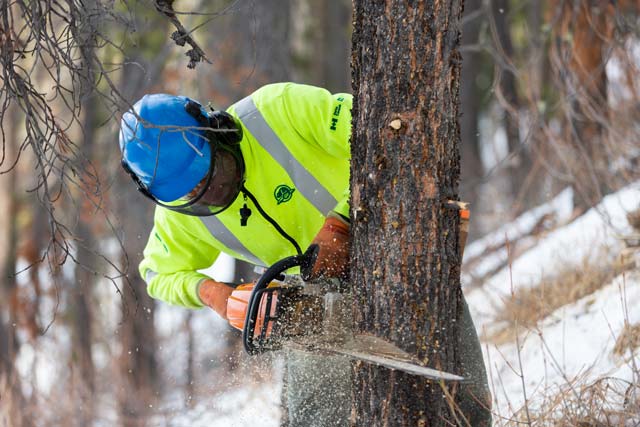
Photo :Photo: Parks Canada / Luuk Wijk Parks Canada / Luuk Wijk
Thanks to public reports and rapid response, Parks Canada fire crews promptly managed and extinguished 15 wildfires this summer, with three over 2 ha in size and requiring more than 12 hours of suppression activities. Most of these wildfires were small and extinguished promptly or within just a few days, thanks to the quick actions of fire personnel and skilled helicopter pilots.
In March 2023, Parks Canada hosted a two-day knowledge-sharing event about fire with Indigenous partners. The Elder and youth gathering had been requested by Indigenous partners at the Jasper Indigenous Forum. Parks Canada staff and partners discussed various recommendations which will support fire management decisions in the future.
Jasper National Park conducted wildfire risk reduction work throughout the fall and winter of 2023, including on the community fireguard on Pyramid Bench and around Pyramid Lake Resort and Patricia Lake Resort. Work included hand-thinning of vegetation and controlled burning of debris to mitigate wildfire risks and manage the impact of mountain pine beetle.
Parks Canada also resumed wildfire risk reduction work along the base of Signal Mountain. Building on work that was done in 2022, the new fireguard links naturally wet areas with more fire-resilient deciduous tree stands along the base of the mountain. Combined with Jasper National Park’s community fireguard, this new fireguard further improves the Jasper townsite’s protection from wildfire.
Aquatic Invasive Species
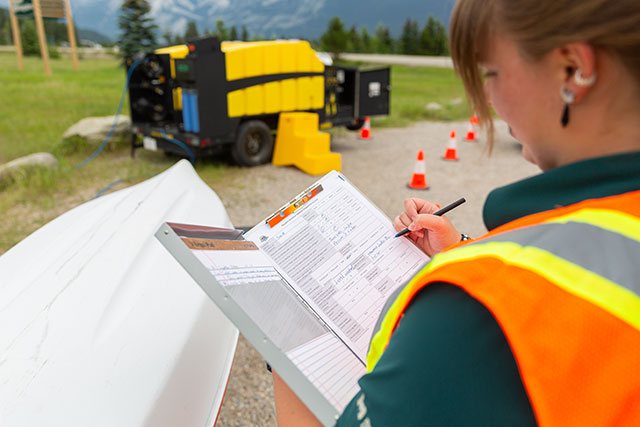
Photo :Photo: Parks Canada / Liam Fenton Parks Canada / Liam Fenton
Protecting aquatic ecosystems relies on the support of all visitors and residents. Jasper National Park’s Aquatic Invasive Species (AIS) prevention program started in 2023, operating seven days a week throughout the summer at a roadside cleaning station and at high-traffic water bodies including Maligne, Talbot, Patricia, Pyramid, Edith and Annette lakes. The AIS team conducted 944 “effectiveness monitoring surveys” and 114 hot washes from June to October to prevent potentially contaminated watercraft from entering park waters. In total, staff engaged with more than 3,000 visitors and residents and the cleaning station and during interpretive and outreach activities throughout the park.
To date, there have been no positive detections of high-risk AIS threats such as whirling disease or invasive mussels in the park. However, in 2023 new cases were detected in Yoho and Kootenay National Parks, which highlights the possible threats to lakes and rivers in Jasper National Park.
Strategy 2: True-to-Place Experiences
Visitor-use management

Photo :Photo: Parks Canada / Luuk Wijk Parks Canada / Luuk Wijk
A new Parks Canada traffic congestion management team assisted motorists at Lake Annette and Maligne Canyon to reduce parking difficulties and helped with finding alternative transportation or locations to visit. The team also monitored and maintained JasperNow, an interactive web map which provides updates on parking availability at highly visited day-use areas. To help support park management and operations planning, there are 50 infrared trail counters and an assortment of vehicle counters in the park.
Bring your own bike!
Active transportation continues to be at the forefront of promotional summer messaging. Visitors are encouraged to “BYOB” (Bring Your Own Bike) or rent one, and use Jasper’s connector trail system to help reduce parking congestion at popular day-use areas, campgrounds and Jasper townsite.
Trail management
Jasper National Park includes 1,070 km of trails and over 80 backcountry campgrounds. The trail network offers day, overnight and multi-day adventures for a range of ages and abilities. In 2023, the Parks Canada trail crew dedicated over 20,000 hours to maintaining and grooming trails, constructing trail infrastructure, maintaining backcountry campgrounds and rebuilding 23 bridges throughout the park.
Working with the Friends of Jasper
Parks Canada continues to work with the Friends of Jasper National Park (Friends of Jasper). In 2023, the Friends of Jasper contributed 1,137 hours of trail work across the park. Projects included operational maintenance, trail realignment and drainage on parts of trails 3, 3e and 7, along with improving sightlines and wayfinding on two unmaintained trails. Over the winter, the Friends of Jasper flat-packed approved local trails for recreational use. Thank you, volunteers!
In-person interpretation

Photo :Photo: Parks Canada / Luuk Wijk Parks Canada / Luuk Wijk
The Parks Canada interpretive team provided daily programming at the Whistlers Campground Amphitheatre and Heritage Fire Hall with additional programming at Wabasso campfire circle and other key nodes throughout the park. Park interpretation programs feature theatre productions, activity stations, campfire events and a speaker series. 23,000 visitors participated in over 200 programs offered in July and August 2023. Interpretive programs focused on promoting park stewardship messages including human-wildlife coexistence, species at risk and aquatic invasive species.
Winter in the park
More than 600,000 visitors enjoy the park between November and April. Much like the rest of the year, sightseeing and walking remain among the most popular activities during the winter period. Parks Canada winter services include avalanche management and snow clearing on roadways, maintaining scenic road corridors for sightseeing and wildlife watching in priority areas, and grooming 40 km of ski trails.
Visitor safety
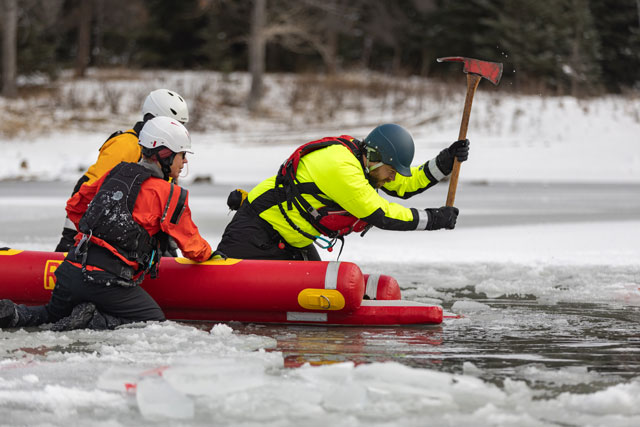
Photo :Photo: Parks Canada / Luuk Wijk Parks Canada / Luuk Wijk
The visitor safety team is responsible for lost person searches, emergency backcountry medical services and traumatic injury rescues in the park. In 2023, the team responded to 171 incidents. The team monitors and manages 76 avalanche paths that impact the Icefields Parkway and Maligne Lake Road.
Visitation
Over the past decade in Jasper National Park, visitation levels have increased by 20%, or an average of 2% per year. In 2023, it is estimated that an all-time high of 2.48 million people visited Jasper National Park.
In 2023, all 11 frontcountry campgrounds were open and were enjoyed by over 520,000 campers. The park recorded 15,100 backcountry users and 32,951 backcountry user-nights in 2023. Low winter snowfall and warm spring weather provided snow-free early season hiking conditions into the alpine and other areas approximately one month earlier than previous years. Close to 70% of the overnight use in the backcountry is concentrated in the four main areas: Skyline, Maligne Lake, Tonquin and Brazeau.
| 2018 | 2019 | 2020 | 2021 | 2022 | 2023 | |
|---|---|---|---|---|---|---|
| Backcountry campers | 13,780 | 14,530 | 14,360 | 17,845 | 14,125 | 15,100 |
| Frontcountry campers | 558,740 | 392,136 | 191,136 | 389,452 | 453,006 | 520,699 |
Total camper numbers are determined by multiplying the number of camping permits sold by 2.8 (the average number in a camping party).
| 2018 | 2019 | 2020 | 2021 | 2022 | 2023 | |
|---|---|---|---|---|---|---|
| Visitation | 2,434,665 | 2,466,485 | 1,672,497 | 2,113,095 | 2,400,000 | 2,482,818 |
Data for 2023 is based on an estimated commercial recovery, with an increase from the 2019 commercial numbers. Individual visitation numbers for 2023 include estimates for December based on a slight increase from the 2021 and 2022 visitation numbers.
Strategy 3: Strengthening Indigenous Relations
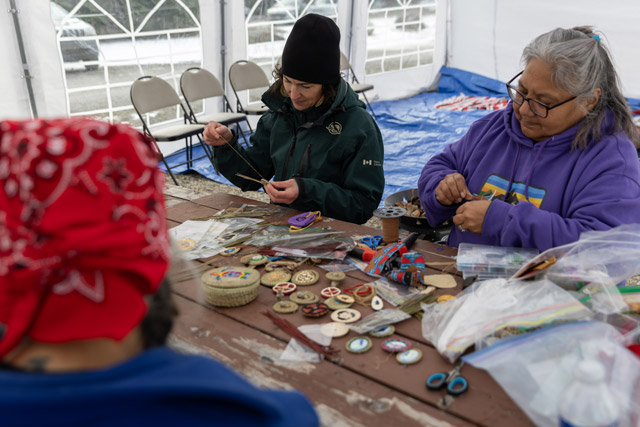
Photo :Photo: Parks Canada / Alexandra Thurm Parks Canada / Alexandra Thurm
Parks Canada works with more than 20 Indigenous groups that comprise the Jasper Indigenous Forum. Indigenous partners and Parks Canada discuss park management and operational issues and collaborate on park projects.
Several in-person engagement sessions and public events were held in 2023, including three pipe ceremonies, the spring and fall Jasper Indigenous Forums, Indigenous Awareness Training, Cultural Use Area engagement, the National Indigenous Peoples Day celebration and National Day for Truth and Reconciliation.
Simpcw First Nation and Stoney Nation Indigenous harvest
Two Indigenous Forum partners, Simpcw First Nation and Stoney Nation reawakened a treaty between their nations that pre-existed park establishment. The agreement, originally signed in 1895, shows the longstanding relationship between the two nations and illustrates their mutual commitment to sharing resources in the Rocky Mountains. By harvesting animals in Jasper National Park, Simpcw First Nation and Stoney Nation increased awareness of Indigenous rights in national parks.
Parks Canada worked with Simpcw First Nation and Stoney Nation to facilitate ceremony and the animal harvest, aligned with shared priorities of safety and conservation.
Opportunities for Indigenous partners to sustainably harvest fauna, in alignment with ecological integrity, are identified as a target in the Jasper National Park Management Plan. A long-term approach to Indigenous harvesting will be developed in the future with Indigenous partner communities connected to Jasper National Park.
Indigenous Exhibit
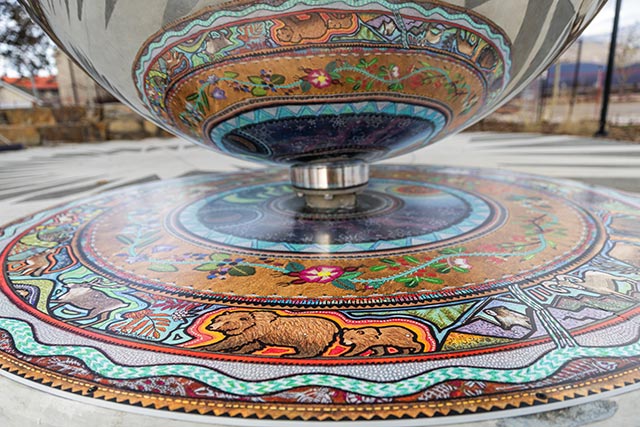
Photo :Photo: Parks Canada / Luuk Wijk Parks Canada / Luuk Wijk
Design and construction of the Indigenous Exhibit beside the Jasper National Park Visitor Information Centre has been guided by the Indigenous Exhibit Working Group, a subgroup of Jasper Indigenous Forum members. The exhibit is nearing completion, and the centrepiece has been installed; an opening ceremony is being planned for the fall of 2024. The centrepiece features a bronze sculpture of an eagle on a large sphere with words from Anishinaabe, Cree, Dene-zaa, Michif, Secwepemctsin and Stoney languages. The sculpture is mounted on a representation of original beaded artwork.
Surrounding the centrepiece are landscaped pathways, seating and panels developed in partnership with more than 15 Indigenous partner groups. Indigenous voices will be represented through storytelling, informational and art panels. Situated at various entry points to the exhibit will be truth telling panels about the forced removal of Indigenous people from the area now known as Jasper National Park.
Connection with the land
Connection with the land is important in addressing the impact of the park’s establishment on Indigenous communities. Throughout 2023, Indigenous partners connected to and spent time in Jasper for healing, ceremony and enjoyment. The Cultural Use Area continues to be an important site for Indigenous partners to gather, camp and host spiritual and community events. Partners accessed the Cultural Use Area to host more than 19 events over the summer and fall of 2023.
Indigenous Awareness Training
Knowledge holders, including Elders and youth from Indigenous partner communities, led Indigenous Awareness Training for staff from Parks Canada, the Municipality of Jasper and Tourism Jasper. The training offered an opportunity for Indigenous partners to break down barriers and provide staff with knowledge and information to increase awareness, share history and build understanding.
“Grandmother’s Medicine” Mural

Photo :Photo: Parks Canada / Luuk Wijk Parks Canada / Luuk Wijk
Artist Sakâw Nehiyaw Iskwew made her mark during the UpLift! Jasper Mural Festival, 2023, in the form of a vivid mural depicting her inspiration – her Kokum (Grandmother), Christie Catt. Sakâw Nehiyaw Iskwew is originally from Slave Lake in Treaty 8 territory. She is Bush Cree from Big Stone Cree Nation and mixed ancestry, including connections to Sawridge Cree Nation. Her English name is Kayla Bellerose.
The stunning “Grandmother’s Medicine” mural on the prominent Parks Canada Heritage Fire Hall building is a gift she hopes will keep on giving by creating a welcoming spot for Indigenous peoples to feel represented and loved.
Strategy 4: Connect, Collaborate and Learn Together

Photo :Photo: Parks Canada / Liam Fenton Parks Canada / Liam Fenton
Education and outreach
Parks Canada delivers education and outreach to enable Canadians, including youth and newcomers, to experience the outdoors and learn about the environment and history of Jasper National Park.
In 2023, the Palisades Stewardship Education Centre reached 11,700 students virtually, hosted 48 groups, and connected with over 800 students in-person at the Marmot Learning Centre.
The Jasper Pride and Ski Festival brought a burst of colour and inclusivity to the Rockies. Parks Canada showed its support for this unique celebration by hosting an afternoon of nature games and family activities.
Getting the word out
Parks Canada helps Canadians learn about shared heritage and experience the outdoors in a safe and enjoyable way by providing visitors with consistent and accurate information. To accomplish this, Jasper National Park leverages its social media channels, newsletters and website to communicate important information, including trail maintenance updates, trip planning, avalanche control information and important updates on events like the June 2023 snowstorm and wildfires in the park.
2023 communication stats include:
- 37,537 X (formerly Twitter) followers (1,657 new followers in 2023)
- 76,866 Facebook fans (7,783 new fans in 2023)
- 71 subscription emails
- 1,194,915 sessions on the Jasper National Park WebsiteFootnote 1
External research permits
In 2023, there were 31 active external research projects in Jasper National Park. These projects gathered leading-edge research data on subjects like mountain pine beetle impacts, glacier dynamics, invasive species, visitor perspectives and geology. These projects will help increase knowledge and assist in park management. Some of these projects have wider-reaching outcomes, such as NASA’s testing of technology on glaciers, which will have future impacts on space exploration, including the search for life on Enceladus, one of Saturn’s moons.
Strategy 5: Managing Development
Built assets
Jasper National Park has over 1,200 built assets, many of which date back to the 1960s and 1970s. This includes 11 road-accessible campgrounds (totalling 2,038 sites), two information centres, seven major day-use areas, 120 pump-out privies, 61 viewpoints and pull-offs, 33 picnic sites, more than 1,000 km of backcountry trails and nearly 400 km of paved roads. To maintain these assets, some of the work undertaken in 2023 included 2,000 m2 of asphalt replaced, 130 campsites refurbished and 50 new picnic tables constructed.
Spill response
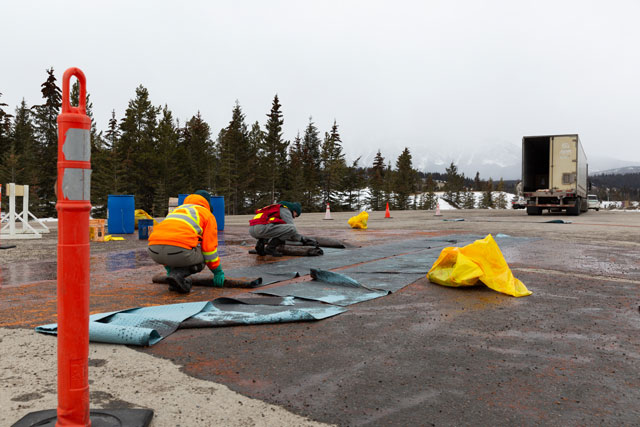
Photo :Photo: Parks Canada / Luuk Wijk Parks Canada / Luuk Wijk
In 2023, Parks Canada staff responded to 33 individual spills in Jasper National Park. These spills were typically related to vehicles and road accidents and consisted of oil, diesel, gas and engine coolant, and included sewage and wildlife attractants. Notably, over 1500 litres of fish oil spilled in an incident on Highway 16 which took nearly 90 hours of staff time for coordination of clean-up activities and restoration of the area.
The company responsible was charged and ordered by the court to repay Parks Canada for the costs of the cleanup in addition to a fine.
Helicopter fuel tank
In 2023, a helicopter fuel tank was installed at the Jasper Field Unit maintenance compound to accommodate increased air traffic for firefighting response and to aid in the response times of emergency services. The new tank represents a financial and environmental gain by reducing the waste and cost associated with transporting barrels of fuel.
Development activity web updates
Parks Canada completed an update of the development activity webpages in 2023 to ensure that development practices are easy to access and understand for all users. More work continues to be done to improve these webpages.
Planning and Development Advisory Committee
In 2023, the Planning and Development Advisory Committee, a five-member public committee which advises the Superintendent on planning and development issues, held nine public hearings and heard 16 applications for discretionary uses, variances and land use policy amendments.
Strategy 6: Climate Change and Adaptation

Photo :Photo: Parks Canada / Luuk Wijk Parks Canada / Luuk Wijk
Climate change and other environmental forces challenge the integrity of ecosystems and the condition of natural and cultural resources in Jasper National Park. The impacts to these places are complex. Parks Canada integrates climate change mitigation efforts and adaptation into our work.
Glacier change
In cooperation with the Geological Survey of Canada, the Parks Canada monitoring team measures glacier melt year to year. The health of a glacier is measured in “mass balance,” which is the total of new snow and ice, minus melt. On the Athabasca Glacier, the monitoring team found that 2023 saw more glacier ice melt than in any of the past 10 years that monitoring has taken place.
Alpine plant phenology
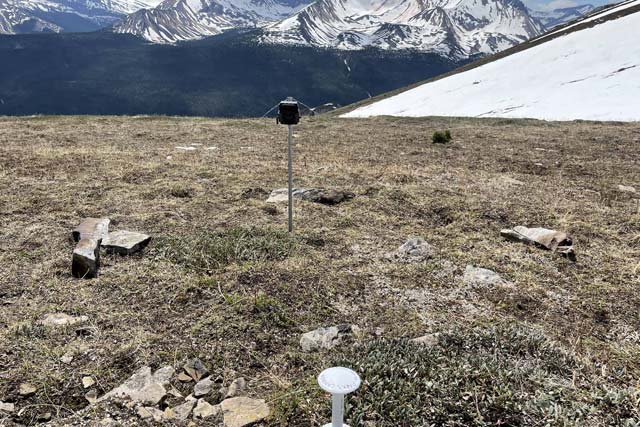
Photo :Photo: Parks Canada Parks Canada
Parks Canada uses daily timed images from cameras at 16 alpine sites throughout Jasper National Park to collect images of plants and flowers and identify alpine plant phenology (when the plants green up in spring and hit peak flowering). With climate change, this timing is expected to shift and affect other species, including birds and pollinators. Alpine plant phenology is a long-term monitoring indicator of how sensitive alpine ecosystems respond to climate change.
Alpine climate forecasts
Parks Canada’s national climate science and advisory team created future climate scenarios to explore the range of climate-related changes predicted across Jasper National Park under different emissions scenarios. By using high-resolution vegetation mapping information, this team was also able to provide alpine-specific climate forecasts, which allow us to identify climate variables that have a greater effect on alpine ecosystems compared to the rest of the park.
The 2023 fire season
Canada’s 2023 wildfire season was the most severe on record, with over 18.5 million hectares burned across the country. Parks Canada continues to support the provincial wildfire management efforts where feasible and when requested. Parks Canada maintains dedicated teams of fire personnel across the country that can be quickly deployed to assist in managing wildfires within Parks Canada administered places, and if requested, in other jurisdictions.
Jasper National Park contributed 14 fire specialists and 17 additional staff (i.e., logistics and Geographic Information System staff) to wildfire emergencies in Alberta, British Columbia and the Northwest Territories. Fires affected neighbouring communities like Edson and the greater Yellowhead County around Jasper National Park. Fire management personnel from Jasper National Park supported firefighting efforts in Edson, and the park opened its gates to those communities’ evacuees and provided park access and camping, where available, free of charge.
Renewable electricity
As of 2023, electricity consumption for the Jasper Field Unit is powered by green energy through a virtual power purchase agreement negotiated by Public Services and Procurement Canada. Purchasing green power supports the Government of Canada’s Greening Government Strategy to power federal buildings with 100% renewable electricity to help fight climate change and support renewable electricity projects.
The 2023 June storm
In June, Jasper experienced a rare summer snowstorm, and received more than 100 mm of rain and 55 cm of snow in some locations. Nicknamed "Juneuary" by locals due to its unseasonal nature, this event led to significant clean-up challenges. Approximately 150 people were rescued across the park, including hikers, paddlers and tour-bus passengers. The trail crew, with significant support from the fire crew, the ecological integrity monitoring team, and others, surveyed hundreds of kilometres of trails for damage and, along with their regular duties, cleared thousands of trees.
Miette Road and Miette Hot Springs closures
Miette Road and Miette Hot Springs were closed from June 19 until September 1 due to significant damage to the road caused by a mudslide, hundreds of downed trees and a significant washout of a portion of the road during the June storm. The Miette Road was reopened with a temporary detour to mitigate risks.
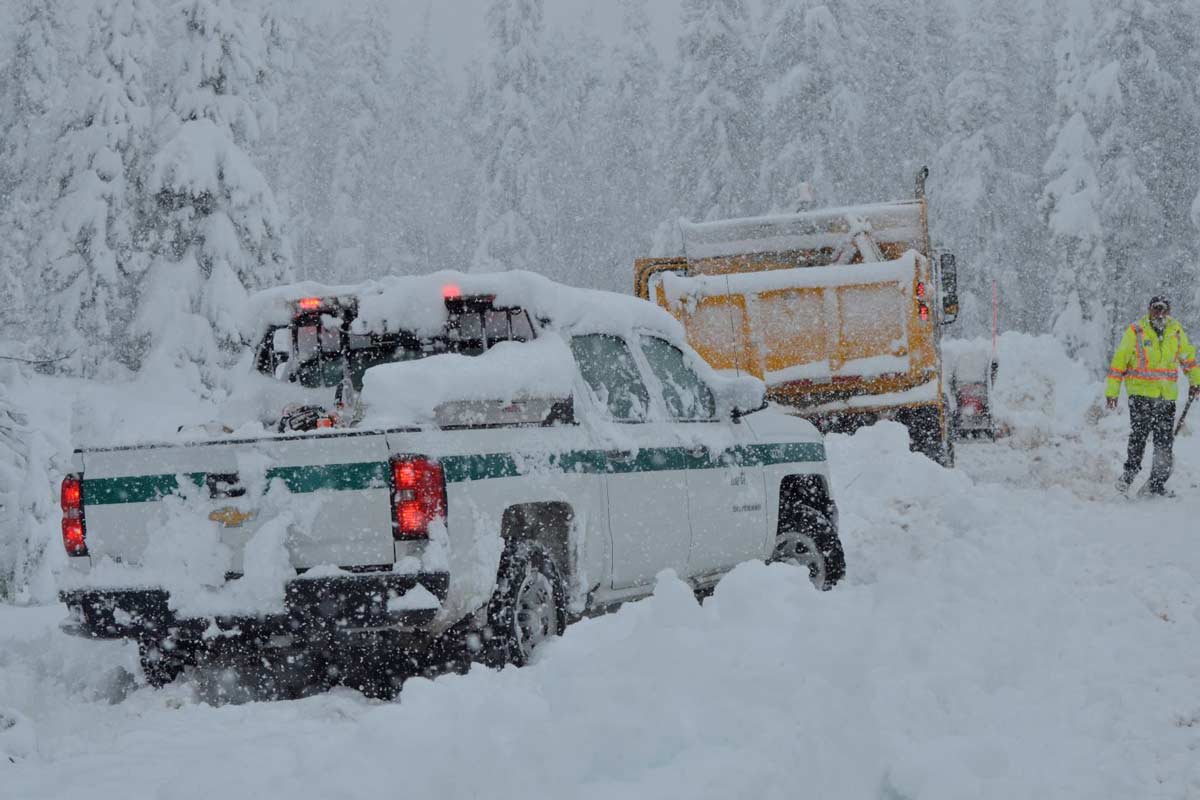
Photo :Photo: Parks Canada Parks Canada
Management Areas
Area management focuses on specific areas of national parks that have complex management challenges—including important natural and cultural values, high visitation, public interest, significant infrastructure and multiple visitor experience opportunities. The Jasper National Park Management Plan (2022) identifies the Community of Jasper and the Tonquin Valley as requiring specific management objectives and targets to guide management in these areas.
Management Area: Community of Jasper
Land use planning

Photo :Photo: Parks Canada / Luuk Wijk Parks Canada / Luuk Wijk
From March to April 2023, the Parks Canada national land use planning team consulted nation-wide on land use planning and development in the Town of Jasper. The national team released a
What We Heard Report highlighting four key themes: improving service delivery, simplifying governance models, updating the community vision, and balancing tourism and local services.
Commercial floor area
The Canada National Parks Act establishes limits on the amount of commercial floor area that can be developed in national park communities. Under the Act, the total amount of commercial floor area (CFA) in the Town of Jasper cannot exceed 118,222 m2. At the time the cap was established in 2001, there was 9,290 m2 of commercial floor area available to be developed. As properties are developed and redeveloped, the amount of commercial floor area remaining under the cap changes over time. The table below summarizes the Town of Jasper’s current commercial floor area allocation.
| C1+C2+C3+C4 | S Block (m2) | Total area (m2) | Percentage of CFA cap total | |
|---|---|---|---|---|
| Commercial CFA remaining as of 2001 | 6,503 | 2,787 | 9,290 | 100% |
| Developed CFA since 2001 | 4,423 | 2,787 | 7,210 | 77.61% |
| CFA remaining | 2,079.71 | 0.00 | 2,079.71 | 22.39% |
Jasper Transit
In September 2023, the Municipality of Jasper launched Jasper Transit, a public transportation program providing service to Jasper townsite, schools, popular day-use areas and campgrounds. Parks Canada supported this initiative by developing bus stops and contributing to program operating costs.
Parks Canada looks forward to continuing to support this initiative as a sustainable public transportation option for locals and visitors.
New housing
In 2023, Jasper National Park issued permits for 13 secondary suites and three garage suites; a development permit for a 12-unit apartment building (construction anticipated for 2024); a building permit for an 18-unit apartment building (currently under construction); and an occupancy permit for an 18-unit apartment building.
Bears and fruit trees
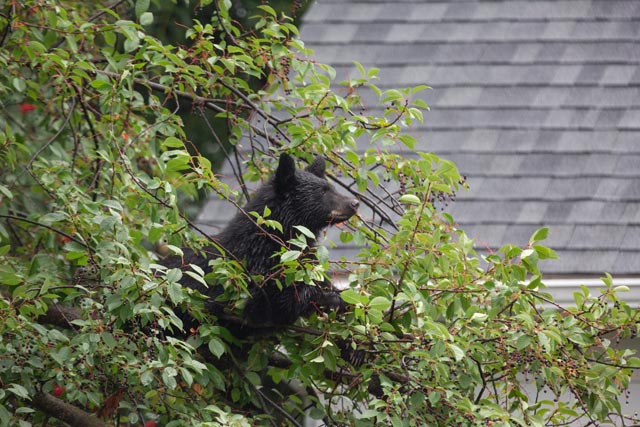
Photo :Photo: Parks Canada / Luuk Wijk Parks Canada / Luuk Wijk
Parks Canada human-wildlife coexistence staff responded to over 400 incidents involving bears within the Jasper townsite in 2023. This represents more than a 30% increase in townsite bear activity compared to 2022. The primary driver of this activity is the attraction of bears to non-native fruit trees. The persistent presence of bears in town raises safety concerns for both residents and visitors. Incidents this past year included bears searching for food in buildings and backyards, bluff-charging dogs and people, and feeding in trees near schools, daycares and playgrounds.
Managing fruit trees and other attractants is the only viable approach to keep bears out of town. Short term strategies such as hazing bears are not effective over time if fruit trees remain, as the reward to the bears usually outweighs the discomfort of the hazing methods. Relocating fruit-conditioned bears from the townsite also has a low success rate and can be hazardous to the bears being moved. In 2023, Parks Canada removed a total of 80 fruit trees from Parks Canada properties, Municipality of Jasper properties, and from private properties within the townsite. Staff also handed out over 100 flyers door to-door to educate residents about removing fruit trees and to provide a list of alternate tree species for planting.
Management Area: Tonquin Valley
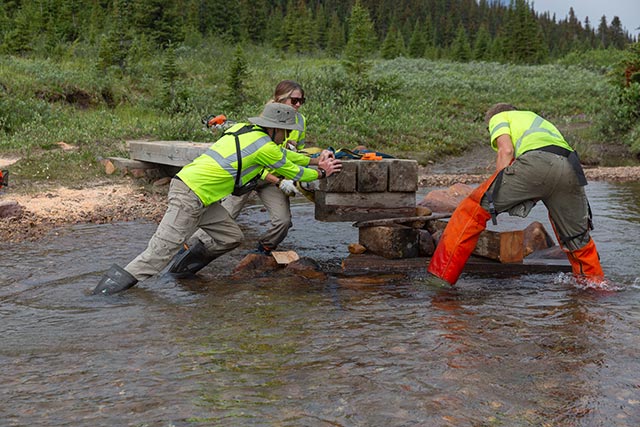
Photo :Photo: Parks Canada / Alexandra Thurm Parks Canada / Alexandra Thurm
The Jasper National Park Management Plan (2022) sets the objective that the ability of keystone species like caribou and grizzly bears to thrive in the Tonquin Valley is improved, while respecting the long history of human use of the area. In 2023, Parks Canada advanced work to support this objective through monitoring of caribou, work on the caribou recovery breeding centre (as outlined under Strategy 1) and maintaining visitor access to this special area May 16 to October 31.
Trail improvements
Parks Canada improved trails in the Tonquin Valley through tread repair in eroded areas and brushing to increase sightlines. Bridges were repaired or replaced at Portal Creek and along the trail to the Wates-Gibson hut.
Law enforcement summary
The law enforcement team is responsible for investigating reports of illegal activity within the national park. Park Wardens assist the public, collect evidence, respond to emerging issues and enforce the Canada National Parks Act, along with its regulations and many other provincial and federal statues. In 2023, Park Wardens addressed 1206 incidents, issued 462 warnings and laid 71 charges.
Financial summary
In the 2023–24 fiscal year, the Jasper Field Unit (which includes Fort St. James National Historic Site in British Columbia) had an operating budget of $25.5 million. The budget is primarily derived from revenue from entry fees, campground fees and land rents.
In 2023–24, 62% of the operating budget was allocated to staff salaries, 20% to operating costs and 17% to capital investments.
Additionally, the field unit received approximately $46.4 million in special funding for projects related to wildfire management, conservation and restoration, and investment in assets, including trails, campgrounds, roads and bridges.
The caribou recovery program is progressing on time and on budget this fiscal year. A total of $24.6 million was allotted in the 2023–24 fiscal year to develop a caribou conservation breeding and augmentation program.
- Date modified :